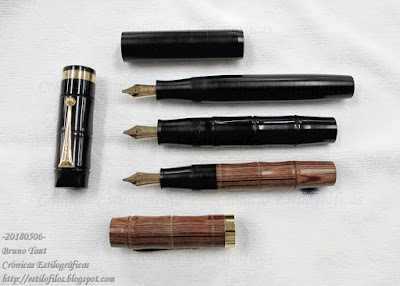As of today, other that the nibs one could order directly from him, it is possible to find Kubo nibs on pens Tohma, made by Toma Kiyotaka of Pen Cluster, and on some models by Iwase Seisakusho, albeit its activity seems currently suspended.
But nibmeister Kubo has a long history in the pen industry in Japan. Two brands associated with Kubo were Nobel –or Nobel's, as he likes to call it-- and Elliott.
The Elliott company was founded by former worker of SSS Uesugi Yoshizaku around 1936 or 1937 in the Kita Ward in Tokyo. Around 1960, Kubo's uncle bought the company and Kubo Kohei started working on it. The engagement with this brand lasted until around 1980.
In parallel, at least during the late 1960s and 1970s, Kubo Kohei also worked on his own brand Nobel. For those pens, he used injected plastic for the bodies and adopted Platinum cartridges and converters as filling mechanisms, as was the common practice among small companies of the moment.

Two Nobel pens: the "Super Gold" model on top; and a pocket pen. Both were made by Kubo Kohei. They use Platinum cartridges.
So these are some of the nibs and pens made by nibmeister Kubo. However, they are not easy to find in the market.
My thanks to Mr. Kanesaki, Mr. Sugimonto and Mr. Sunami.
Note (Sept 1st, 2019): I have changed some of the original pics form some others with better quality.
Pilot Custom 74 – Wagner 2008 (Sailor)
Bruno Taut
Nakano, August 30th 2019
etiquetas: Nobel, Elliott, Nobel, Tohma Pens, Iwase Seisakusho, nibmeister Kubo Kohei
Bruno Taut
Nakano, August 30th 2019
etiquetas: Nobel, Elliott, Nobel, Tohma Pens, Iwase Seisakusho, nibmeister Kubo Kohei

































































